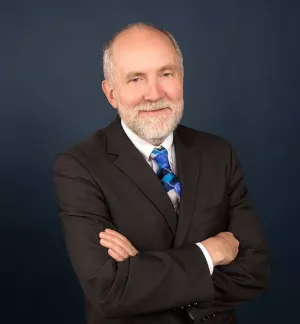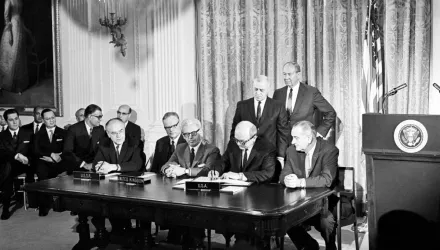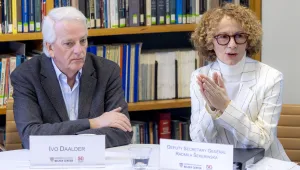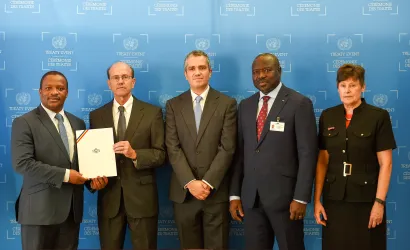
On December 5, 1994, leaders of the United States, the United Kingdom, and the Russian Federation met in Budapest, Hungary, to pledge security assurances to Ukraine in connection with its accession to the Treaty on the Nonproliferation of Nuclear Weapons (NPT) as a non-nuclear-weapons state. The signature of the so-called Budapest Memorandum concluded arduous negotiations that resulted in Ukraine’s agreement to relinquish the world’s third-largest nuclear arsenal, which the country inherited from the collapsed Soviet Union, and transfer all nuclear warheads to Russia for dismantlement. The signatories of the memorandum pledged to respect Ukraine’s territorial integrity and inviolability of its borders, and to refrain from the use or threat of military force. Russia breached these commitments with its annexation of Crimea in 2014 and aggression in eastern Ukraine, bringing the meaning and value of security assurance pledged in the Memorandum under renewed scrutiny.
On the occasion of the 25th anniversary of the memorandum’s signature, the Project on Managing the Atom at the Belfer Center for Science & International Affairs at the Harvard Kennedy School, with the support of the Center for U.S.-Ukrainian Relations and the Harvard Ukrainian Research Institute, hosted a conference to revisit the history of the Budapest Memorandum, consider the repercussions of its violation for international security and the broader nonproliferation regime, and draw lessons for the future. The conference brought together academics, practitioners, and experts who have contributed to developing U.S. policy toward post-Soviet nuclear disarmament, participated in the negotiations of the Budapest Memorandum, and dealt with the repercussions of its breach in 2014. The conference highlighted five key lessons learned from the experience of Ukraine’s disarmament.1
Ash Carter (left), Director of the Belfer Center and former Secretary of Defense, is interviewed during the conference by Matthew Bunn, HKS Professor of Practice and Co-PI for the Project on Managing the Atom.
(Benn Craig/Belfer Center)
-
Individual initiative and creativity are critical in uncertain times
The unprecedented disintegration of a nuclear superpower, the Soviet Union, in 1991 raised the specter of the single greatest wave of nuclear proliferation in history. Virtually overnight, the Soviet Union’s vast nuclear arsenal was on the territory of not one, but four sovereign states: Belarus, Kazakhstan, Russia, and Ukraine.2 By 1994, Belarus, Kazakhstan, and Ukraine had all joined the NPT as non-nuclear-weapon states, and by 1996 all nuclear warheads were transferred from their territory to Russia, which alone succeeded the Soviet Union as a nuclear-weapons state under the NPT.
This fortunate outcome was not preordained. In 1992-1993, Ukraine, concerned about its security vis-a-vis Russia, as well as about getting a fair deal, had real misgivings about surrendering its nuclear inheritance. While operational control over nuclear arms in Ukraine remained in Moscow and Ukraine lacked key elements of a nuclear weapons program, it possessed the scientific and technological capacity to develop the missing links in a relatively short time. Indeed, in mid-1993, many units of the Strategic Rocket Forces that were on Ukraine’s territory, including those with physical custody of nuclear warheads, took Ukrainian military oaths. Reports emerged that Ukraine has been making attempts to gain control over the nuclear control systems.3
At the time when history and existing policies provided little guidance for dealing with these challenges, individual initiative and creativity made a difference, as was pointed out by William Tobey, a senior fellow at the Belfer Center and at the time a member of President George H.W. Bush's National Security Council (NSC) staff. For example, Susan Koch, also on the NSC staff as the Soviet Union neared collapse, outlined the Presidential Nuclear Initiatives (PNIs), in which President Bush announced unilateral arms control measures to consolidate and de-alert nuclear forces, in the hope, quickly realized, that Soviet President Mikhail Gorbachev would take reciprocal action.4 Among other things, the PNIs provided for the withdrawal of tactical nuclear weapons to central storage facilities, which allowed Moscow to remove all tactical nuclear weapons from the non-Russian republics by May 1992.
Another innovative step was to provide assistance for safe and secure dismantlement of nuclear weapons systems to the crisis-stricken former Soviet Union. Creative thinking originating at the Belfer Center, with conference participants Ash Carter and Graham Allison among those leading the effort,5 combined with ingenious legislative entrepreneurship by Senators Sam Nunn (D-GA) and Richard Lugar (R-IN), convinced the United States Congress to adopt the Cooperative Threat Reduction (CTR) Act in December 1991.6 Under the CTR program, the Congress appropriated funds from the U.S. defense budget to help dismantle weapons and strengthen controls in countries that until recently comprised America’s archenemy.7 Carter and Allison would go on to become assistant secretaries of defense in the administration of President Bill Clinton, where their mandate included overseeing U.S. security relations with the former Soviet states, in particular, the implementation of CTR assistance projects.
In Ukraine, CTR assistance helped dismantle its 176 intercontinental ballistic missile complexes and 44 strategic bombers, transport some 2,000 strategic nuclear warheads to Russia for disassembly, support the development of proper protection and accounting systems for nuclear materials at its civilian facilities, and even provide housing for nuclear officers who were no longer needed.8 At the conference, Carter highlighted the role this assistance, as well as the tireless work of men and women implementing it on the ground, played in supporting Ukraine’s sovereign decision to eliminate the nuclear weapons on its soil.
Another key innovation where individuals made a striking difference was the U.S. purchase of low-enriched reactor fuel blended down from hundreds of tons of highly enriched uranium (HEU) from dismantled Soviet warheads. This was originally proposed by MIT scholar Thomas Neff, who worked tirelessly to suggest ways past the obstacles that arose.9 "Megatons to Megawatts," as the program became known, also played an important role in Ukraine’s disarmament, providing compensation for the value of the HEU contained in the warheads removed from Ukraine, both strategic and tactical, in the form of fuel assemblies for Ukraine’s nuclear power plants from Russia, underwritten by the United States. Indeed, conference participant James Timbie, then an advisor at the U.S. State Department, helped arrange a complex pre-payment that gave Russia’s nuclear ministry the cash it needed to provide fuel for Ukraine even before deliveries of blended down uranium to the United States had earned enough money to cover the cost.
Graham Allison, who was Assistant Secretary of Defense in the Clinton administration, delivers the conference's Welcome Address.
(Benn Craig/Belfer Center)
-
Arms control and nonproliferation institutions matter
While prompt and innovative policy responses were critical to the outcome, so were the existing bilateral U.S.-Soviet arms control architecture and the international nonproliferation regime. Both served to determine the rules of the road and the parameters for engagement with the former Soviet republics.10
In the fall of 1991 as the Soviet Union was disintegrating, the United States quickly formulated its stance that no new nuclear states should emerge from the Soviet collapse.11 This was not an idiosyncratic demand, but a policy aimed at maintaining the object and purpose of the NPT, which already comprised over 160 member states and recognized only five nuclear possessors, barring all other parties from nuclear acquisition. As a result, U.S. demands that the non-Russian successors to the Soviet Union join the NPT as non-nuclear-weapon states enjoyed broad international support. Without the NPT and global consensus against the further spread of nuclear weapons, the retention of nuclear weapons by Ukraine might have been seen in Kyiv as elevating its national status rather than making it an international pariah.
Thomas Graham, Jr., who at the time served as acting director of the U.S. Arms Control and Disarmament Agency, emphasized that while Ukraine made claims to be the legitimate owner of the Soviet nuclear arms it inherited, the existence of the NPT would have made it difficult for Ukraine to legitimize such claims over the long term.12 In the end, Ukraine, as an aspiring European democracy, was keen to join the international community on good terms, something that could not have been achieved without its accession to the NPT as a non-nuclear-weapons state.
At the same time, as former Soviet arms negotiator Nikolai Sokov noted, U.S.-Soviet arms control treaties also played a critical role. The 1987 Intermediate-Range Nuclear Forces (INF) Treaty and the 1991 Strategic Arms Reductions Treaty (START) provided precise arms accounting, transparency-building verification approaches, and specific reduction and dismantlement requirements around which assistance could be focused and justified. They provided an overall legal framework for strategic nuclear arms reductions in Russia and for complete dismantlement in the non-Russian successor states.13
In regard to Soviet arms control obligations, the NPT helped foreclose a dangerous opening. While Belarus, Kazakhstan, Russia, and Ukraine all became parties to the START treaty as Soviet successor states, under the 1992 Lisbon Protocol, they each committed to join the NPT as non-nuclear weapons states, rather than attempting to be successors to the Soviet Union’s nuclear-weapons-state status.14 Indeed, while the non-Russian states of the former Soviet Union were recognized Soviet successors for many treaties, including limits on conventional arms, recognizing them as such in the nuclear realm would have been contrary to the object and purpose of the NPT to curb the spread of nuclear weapons around the world.15
Thomas Graham Jr. (second from right), former Acting Director
of the Arms Control and Disarmament Agency, speaks on a panel with (from left) Mariana Budjeryn, Project on Managing the Atom Research Fellow; William H. Tobey, Belfer Center Senior Fellow and former National Security Council (NSC) staff; and Susan Koch, former NSC and Department of Defense staff.
(Benn Craig/Belfer Center)
-
The significance of the Budapest Memorandum goes beyond its letter
While Ukraine’s desire to be an international citizen in good standing, technical assistance, and HEU compensation were all important factors in its decision to surrender nuclear weapons, security concerns were central from the outset. Outlining the course of the negotiations, James Timbie noted that Ukraine’s leaders pushed hard to obtain robust and legally-binding security guarantees from the United States. But the United States, wary of undertaking any new security commitments, was unwilling to provide them. In the end, the negotiators found a politically acceptable compromise by crafting assurances that reiterated pledges to respect Ukraine’s territorial integrity and inviolability of its borders, and to refrain from the use or threat of military force, already contained in the UN Charter and the Helsinki Final Act of the Organization for Security and Cooperation in Europe (OSCE), as well as negative and positive NPT-related nuclear security assurances.16
After a twenty-year hiatus, during which the existence of the Budapest Memorandum was all but forgotten, Russia, one of the Memorandum’s signatories, used military force to annex Ukraine’s peninsula of Crimea in March 2014. Billing Ukraine’s popular protests, which deposed its Russia-backed president Viktor Yanukovych, as a CIA-backed “coup” meant to complete the encirclement of Russia and eventually lead to Ukraine’s accession to NATO, Russia deemed its actions justified on the basis of its national security imperatives.
The United States and the United Kingdom fulfilled the letter of the Memorandum by immediately bringing the issue of the Russian violation before the UN Security Council. As noted by Ukraine’s former Ambassador to the UN Yuriy Sergeyev, despite Russia’s veto of the Security Council resolution denouncing Russian actions in Crimea in March 2014, the overwhelming support of the UN General Assembly for Ukraine’s territorial integrity left no doubt regarding the illegal nature of Russia’s land-grab.17 The United States, the United Kingdom, and Ukraine also convened consultations of the signatories, as the memorandum envisions, but Russia refused to take part. None of these actions, however, prevented further Russian military action in Ukraine’s eastern province of Donbas, which fueled a war that so far has taken 13,000 military and civilian lives.
Justifiably, Ukrainian leaders and the public feel betrayed and violated by Russia. They also feel that the Western signatories of the memorandum, the United States and United Kingdom, should have done more to support Ukraine after the Russian invasion. While the letter of the memorandum did not specify consequences for violating it or obligate the United States or the United Kingdom to come to Ukraine’s defense, at the conference both Ukrainian and U.S. negotiators of the Memorandum, Borys Tarasyuk and Steven Pifer, agreed that the spirit of the memorandum bound the United States to take a keen interest in Ukraine’s security.18 Both former diplomats argued that the United States and European countries should have done more for Ukraine’s security, both before and after Russia’s intervention.
Pifer also argued that the failure of the West to extend more support to Ukraine in the wake of Russian aggression may have detrimental consequences for the international nonproliferation regime, leading future nonproliferation efforts to require more ironclad commitments. The United States and its allies eventually stepped up efforts to strengthen Ukraine’s armed forces through training and provision of lethal defensive arms, an effort that has resulted in a significant improvement of Ukraine’s defense capability. Recently, however, Ukraine has unwittingly found itself at the center of the U.S. impeachment scandal, spurred by allegations that U.S. President Donald Trump withheld the provision of military assistance to Ukraine in order to advance his personal political agenda. This calls sustainable U.S. support into even deeper question and further undermines the nuclear nonproliferation regime.19
Steven Pifer (center), former US Ambassador to Ukraine, speaks on a panel with (from left) Mary Sarotte, Marie-Josée and Henry R. Kravis Distinguished Professor of Historical Studies at Johns Hopkins University; James Timbie, former advisor to the US State Department; Borys Tarasyuk, former Minister of Foreign Affairs of Ukraine; and Nikolai Sokov, former staffer of the Ministry of Foreign Affairs of USSR and Russia.
(Benn Craig/Belfer Center)
-
Nuclear weapons would likely have become a security liability, not an asset, for Ukraine
In view of Russia’s breach of the Budapest Memorandum and the insufficient Western response, many in Ukraine and some in the West believe that Ukraine would be better off today had it kept a nuclear deterrent. On the anniversary of the Budapest Memorandum, Ukrainian newspapers described it as the greatest “treason” in Ukraine’s history.20 This line of reasoning, however, erroneously assumes that a world in which Ukraine became a nuclear power would have remained unchanged in every other way. A number of conference participants pointed out that Ukraine’s effort to take control of those weapons in the 1990s would have incurred major risks to Ukraine’s security and sovereignty, as well as major economic and political costs.
The United States and Europe made clear that for Ukraine to acquire control of nuclear weapons would mean violating the NPT, as well as Ukraine’s own initial pledge to become a non-nuclear state.21 Desperately needed economic assistance, International Monetary Fund and World Bank restructuring funds, and military cooperation within NATO’s Partnership for Peace program would not have been forthcoming.
Borys Tarasyuk, former Minister of Foreign Affairs of Ukraine, speaks during a conference panel.
(Benn Craig/Belfer Center)
Russia, too, would not have been a passive bystander. At the very least, it would have sought to sabotage Ukraine’s nuclear weapons program or to co-opt it into its military-strategic realm; at the worst, it might have used military force to prevent a nuclear-armed Ukraine on its border. Very possibly, Ukraine would not be an independent country today if it had sought to seize control of nuclear weapons then. Nuclear disarmament was a geopolitical choice by Ukraine’s leaders: painful though it might have been, it enabled the emergence of Ukraine as an independent state and a strategic partner to the West.
Rose Gottemoeller, former Deputy Secretary General of NATO, speaks during a conference panel.
(Benn Craig/Belfer Center)
-
Written agreements are only the beginning
After the memorandum was signed in 1994, the real disarmament work had begun in earnest: the nuclear missiles and infrastructure on Ukraine’s soil were dismantled, nuclear warheads shipped to Russia for disassembly, and housing built for the now-retired personnel of the missile forces. The CTR program and the personal relationships that grew out of cooperative efforts were crucial to getting that work done. At the conference, Ash Carter highlighted the steadfast leadership of then-U.S. Defense Secretary Bill Perry in advancing CTR work in the former Soviet Union. Graham Allison noted that weathering the collapse of a nuclear superpower armed with tens of thousands of nuclear weapons, without losing one and without ending up with more nuclear weapon states, was one of the remarkable and surprising success stories of the 1990s.
Conference participants also noted what failed to happen. After its signature in 1994, the Budapest Memorandum could have served as the foundation for a US-Ukrainian strategic partnership and for broad defense cooperation. For a variety of reasons on both sides, however, the promise of the memorandum was allowed to go unfulfilled. Ihor Smeshko, Ukraine’s first military attaché in Washington in 1992-1996, argued that the United States had failed to find a place for Ukraine in its overall strategy. Rose Gottemoeller, who, until recently, served as the Deputy Secretary-General of NATO and formerly oversaw the work of denuclearization at the NSC, pointed out that the Budapest Memorandum bought Ukraine two decades of peaceful development, yet the country had not taken proper advantage of this time to reform its political and defense institutions.
After 2014, however, the United States and its NATO allies stepped up engagement with Ukraine. While the assistance provided by the West was not expressly couched in terms of the commitments pledged in 1994, Ukraine and NATO today enjoy a robust and mutually beneficial defense cooperation. Some Ukrainian conference participants were enthusiastic about and grateful for the military assistance the United States and other NATO countries have provided, while others were pushing for broader steps, such as bringing Ukraine into NATO or designating Ukraine as a major non-NATO ally of the United States.
Col. Hennadiy Kovalenko, staff officer, NATO Supreme Allied Commander Transformation HQ, speaks on a panel with Rose Gottemoeller, former Deputy Secretary General of NATO; and Yuriy Sergeyev, former Ukrainian Ambassador to the UN.
(Benn Craig/Belfer Center)
Ukraine’s prospects of NATO membership remain far-fetched and disagreements about the terms spelled out in the Budapest Memorandum 25 years ago persist. The Ukrainian military and defense establishment is nevertheless actively collaborating with its Western partners to combine NATO best practices with combat experience in the Donbas to bolster Ukraine’s indigenous defense capacity, according to Col. Hennadiy Kovalenko, staff officer at the NATO Allied Command Transformation Headquarters. Gottemoeller stressed that NATO-Ukraine cooperation is not a one-way street: the alliance is taking onboard many of the lessons from Ukraine’s experience of fighting a hybrid war with Russia.
Indeed, the very fact that the last presentation of the conference was delivered by a Soviet-trained military officer, in a Ukrainian uniform, working at NATO speaks volumes for the tectonic shifts in the world over the past three decades. Ukraine’s struggles are far from over: the country’s geography forces it to find a long-term, sustainable solution in its relations with Russia, while safeguarding its security, independence, and the development of its fragile democratic institutions—without nuclear weapons.
The flag of Ukraine on the uniform of Col. Hennadiy Kovalenko, staff officer, NATO Supreme Allied Commander Transformation HQ.
(Benn Craig/Belfer Center)
Budjeryn, Mariana and Matthew Bunn. “Budapest Memorandum at 25: Between Past and Future.” Managing the Atom Project, Belfer Center, March 2020
- The conference took place in Cambridge on December 6, 2019. Mariana Budjeryn is a post-doctoral research fellow at the Belfer Center’s Project on Managing the Atom. Matthew Bunn is a professor of practice at the Harvard Kennedy School.
- Nuclear weapons had been withdrawn from Eastern Europe and from other former Soviet republics before August 1991.
- See Mariana Budjeryn and Polina Sinovets, Interpreting the Bomb: Ownership and Deterrence in Ukraine’s Nuclear Discourse, NPIHP Working paper #12 (Woodrow Wilson International Center for Scholars, December 13, 2017), https://www.wilsoncenter.org/publication/interpreting-the-bomb-ownershi….
- For a detailed treatment of PNIs, see Susan J. Koch, The Presidential Nuclear Initiatives of 1991-1992 (Washington, DC: National Defense University, September 2012).
- See Kurt M. Campbell, Ashton B. Carter, Steven E. Miller, and Charles A. Zraket, Soviet Nuclear Fission: Control of the Nuclear Arsenal in a Disintegrating Soviet Union, CSIA Studies in International Security (Cambridge, MA: Harvard Kennedy School, November 1991).
- Soviet Nuclear Threat Reduction Act of 1991, Public Law No: 102-228, 1992, https://www.congress.gov/bill/102nd-congress/house-bill/3807/text?q=%7B….
- On the origins and early implementation history of the CTR program, see Ashton B. Carter and William J. Perry, Preventive Defense: A New Security Strategy for America (Washington, DC: Brookings Institution Press, 1999).
- For an in-depth study of CTR work in the Former Soviet Union, see Joseph P. Harahan, With Courage and Persistence: Eliminating and Securing Weapons of Mass Destruction with the Nunn-Lugar Cooperative Threat Reduction Programs, DTRA History Series (Defense Threat Reduction Agency, U.S. Department of Defense, 2014).
- Thomas L. Neff, “A Grand Uranium Bargain,” The New York Times, October 24, 1991, http://fissilematerials.org/library/A_Grand_Uranium_Bargain.pdf.
- See Mariana Budjeryn, “The Power of the NPT: International Norms and Ukraine’s Nuclear Disarmament,” The Nonproliferation Review 22, no. 2 (June 2015): 203–237.
- See the address of US Secretary of State James Baker at Princeton outlining US policy. U.S. Department of State, Office of the Assistant Secretary/Spokesman, “‘America and the Collapse of the Soviet Empire: What Has to Be Done’. Address by Secretary of State James A. Baker, III at Princeton University,” December 12, 1991.
- Thomas Graham’s recollections of his role in post-Soviet nuclear disarmament are recorded in Thomas Graham, Jr., Disarmament Sketches: Three Decades of Arms Control and International Law (Seattle, WA: University of Washington Press, 2002).
- On the role of arms control treaties, including the follow-on START II treaty, in post-Soviet nuclear disarmament, see Nikolai Sokov, Russian Strategic Modernization: The Past and Future (Lanham, MD: Rowman & Littlefield Publishers, Inc., 2000).
- Protocol to the Treaty Between the United States of America and the Union of Soviet Socialist Republics on the Reduction and Limitation of Strategic Offensive Arms, May 23, 1992, https://www.state.gov/documents/organization/27389.pdf.
- For a nuanced treatment of the post-Soviet arms control succession dilemma, see George Bunn and John Rhinelander B., “The Arms Control Obligations of the Former Soviet Union,” Virginia Journal of International Law 33, no. 323 (1993 1992): 323–350.
- “Memorandum on Security Assurances in Connection with Ukraine’s Accession to the Treaty on the Nonproliferation of Nuclear Weapons,” December 5, 1994, http://www.securitycouncilreport.org/atf/cf/%7B65BFCF9B-6D27-4E9C-8CD3-….
- United Nations Security Council, “Security Council Fails to Adopt Text Urging Member States Not to Recognize Planned 16 March Referendum in Ukraine’s Crimea Region,” March 15, 2014, https://www.un.org/press/en/2014/sc11319.doc.htm; United Nations General Assembly, “Resolution A/68/262. Territorial Integrity of Ukraine,” March 27, 2014, https://undocs.org/a/68/l.39.
- For the role of security assurances in US-Ukrainian nuclear negotiations, see Steven Pifer, The Trilateral Process: The United States, Ukraine, Russia and Nuclear Weapons, Arms Control Series (Brookings, May 2011), http://www.brookings.edu/~/media/research/files/papers/2011/5/trilatera…; Mariana Budjeryn, “The Breach: Ukraine’s Territorial Integrity and the Budapest Memorandum,” Woodrow Wilson Center NPIHP, September 2014, http://www.wilsoncenter.org/sites/default/files/Issue%20Brief%20No%203-….
- Mariana Budjeryn, “Impeachment Backstory: The Nuclear Dimension of US Security Assistance to Ukraine,” Bulletin of the Atomic Scientists, November 13, 2019, https://thebulletin.org/2019/11/impeachment-backstory-the-nuclear-dimen….
- See, for instance, Yuriy Havrylechko, “Budapeshtskiy Memorandum: 25 Richnytsya Naibilshoii Zrady v Istorii Ukraiiny [Budapest Memorandum: The 25th Anniversary of the Greatest Treason in the History of Ukraine],” Glavkom, December 5, 2019, https://glavcom.ua/columns/gavrylychenko/budapeshtskiy-memorandum-25-ri….
- See Verkhovna Rada of the Ukrainian SSR, Deklarat͡sii͡a pro Derz͡havnyĭ Suverenitet Ukraïny [Declaration of State Sovereignty of Ukraine], 55-XII, July 16, 1990, http://zakon1.rada.gov.ua/cgi-bin/laws/main.cgi?nreg=55-12; Verkhovna Rada of Ukraine, Zai͡ava pro Bez’i͡adernyĭ Status Ukraïny [Statement on the Nonnuclear Status of Ukraine], 1697-XII, October 24, 1991, http://zakon2.rada.gov.ua/laws/show/1697-12.







